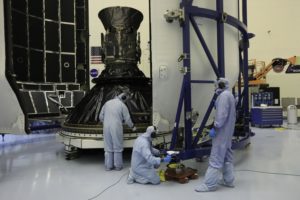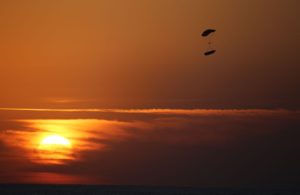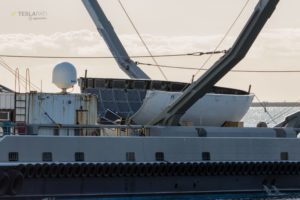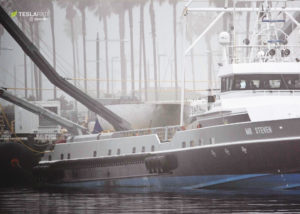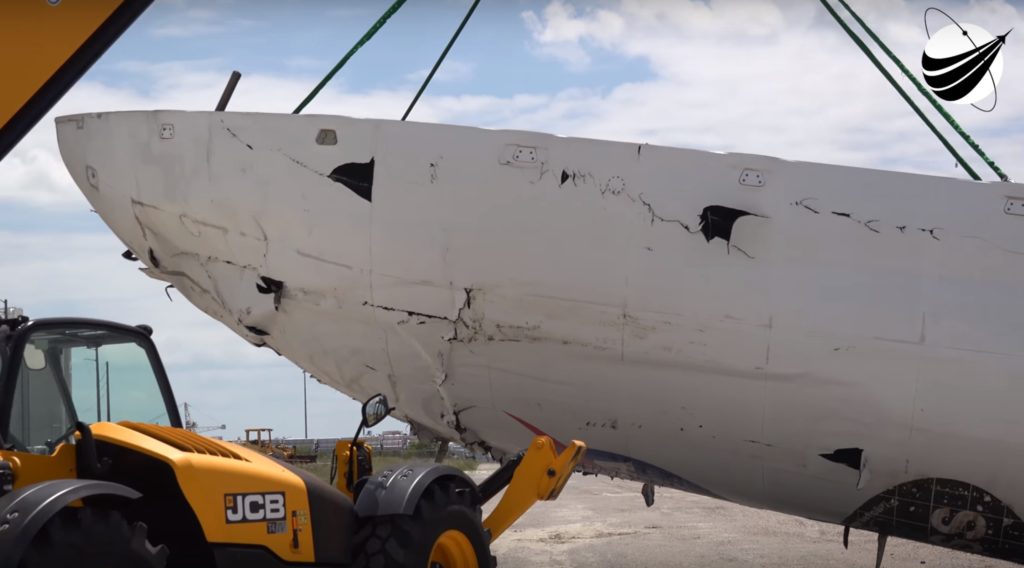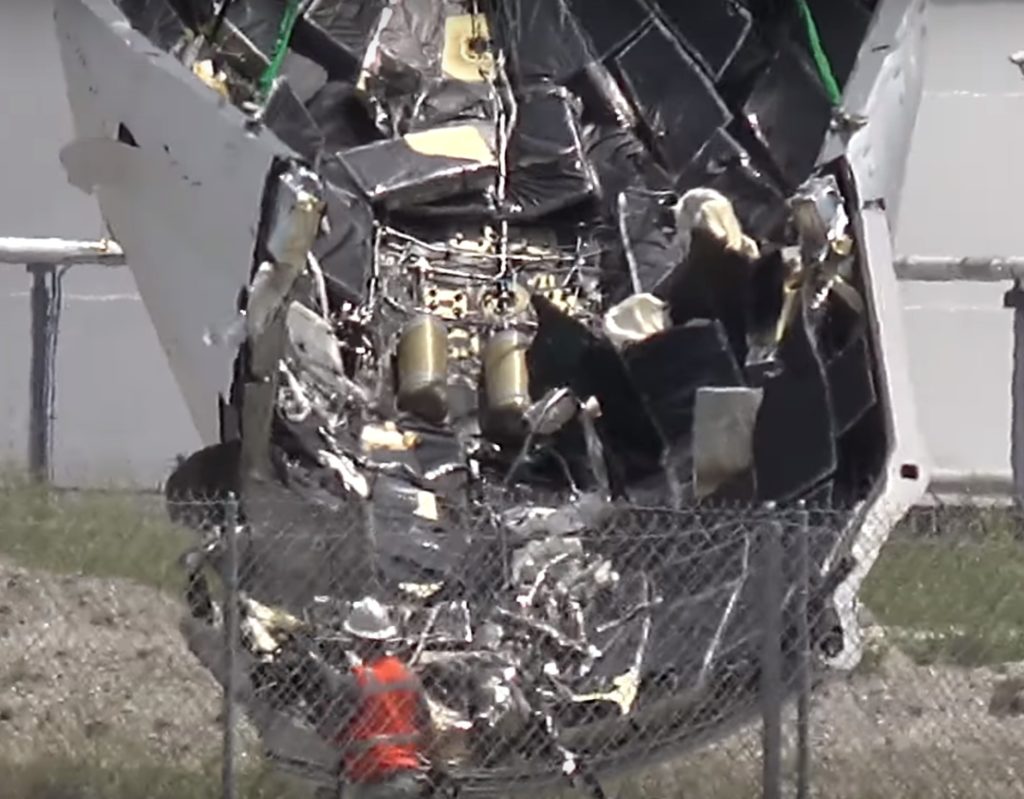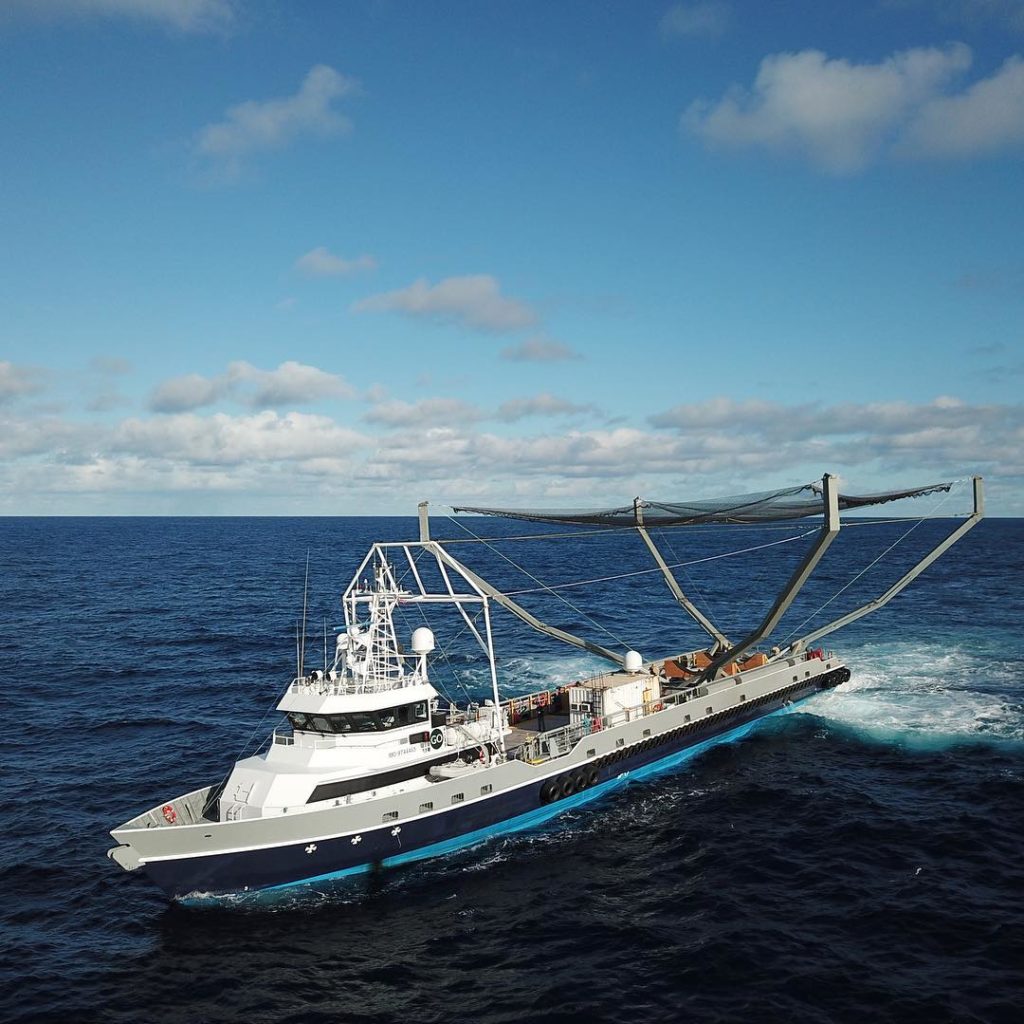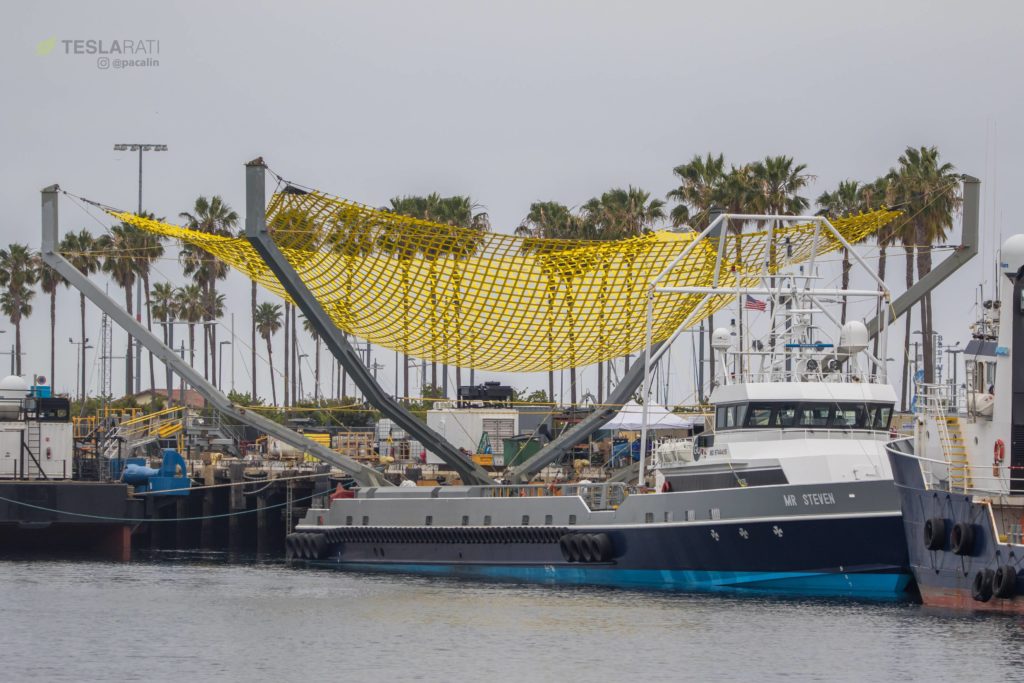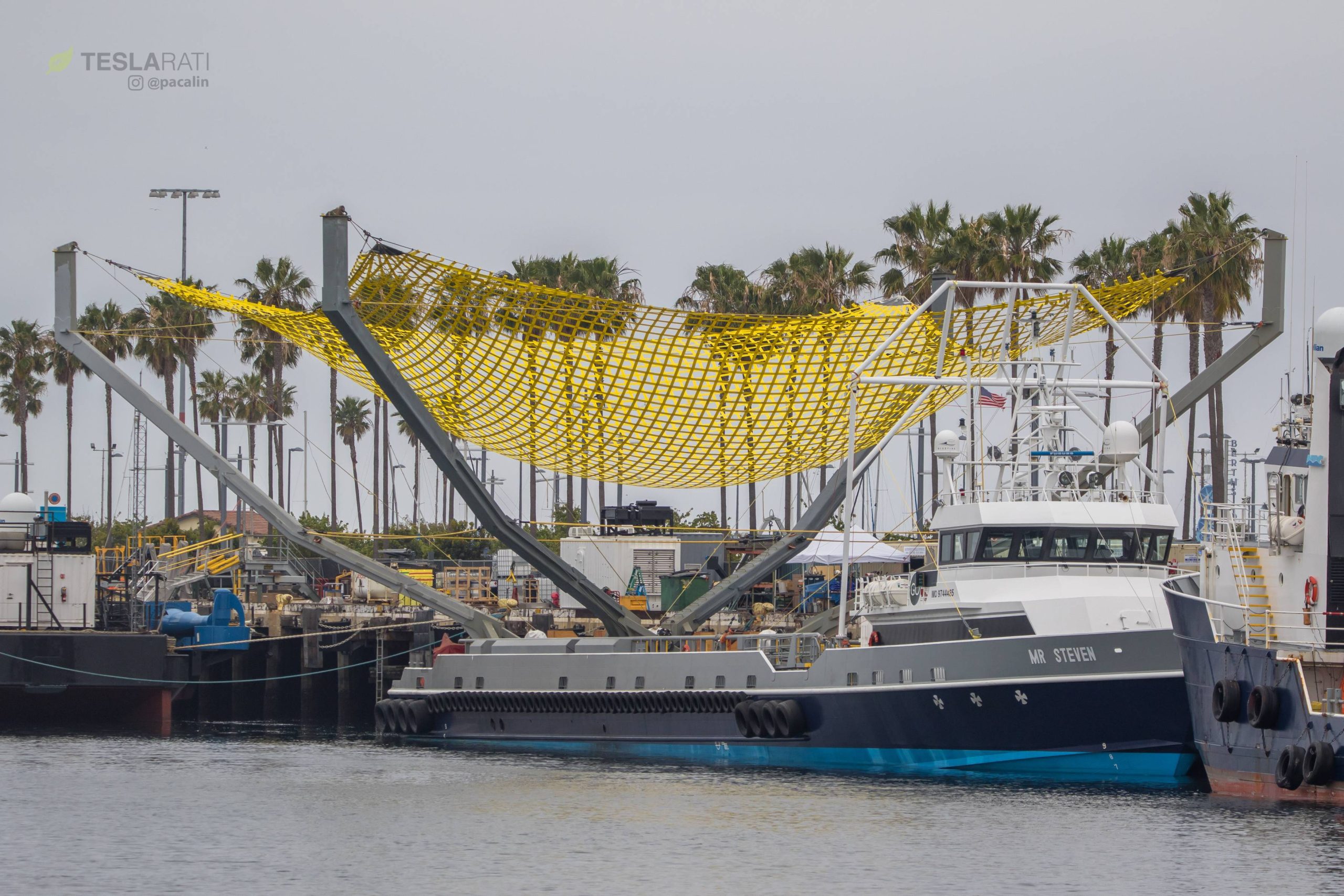
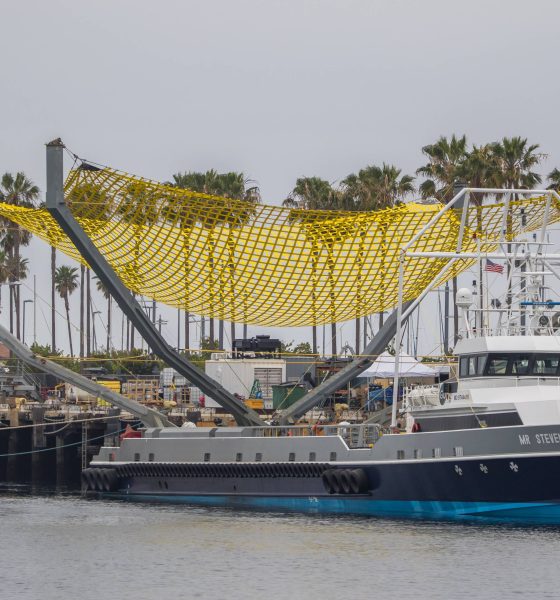
News
SpaceX’s recovery boat Mr Steven has a new net to catch Falcon 9 fairings
While photographer Pauline Acalin just barely missed a toasty Cargo Dragon returning to roost earlier that morning, a routine checkup on SpaceX’s Port of Los Angeles facilities revealed a hefty new net installed on the recovery boat Mr. Steven, as well as noteworthy activity at the huge tent currently harboring the rocket company’s BFR tooling.
After completing a thrillingly routine International Space Station resupply mission (SpaceX’s fourteenth) and spending a month on orbit, the commercial spacecraft reentered Earth’s atmosphere at a respectable 7.5 km/s before splashing down in the Pacific Ocean for the second time. Currently, SpaceX’s Dragon capsule is the only operational spacecraft capable of returning an appreciable amount of cargo from the ISS, and Capsule 110 (1 referring to Dragon 1, 10 referring to the tenth integrated spacecraft) returned even more cargo (nearly 2 mT) than it delivered to the ISS, including the space robot Robonaut 2, various completed experiments, and expired hardware. As of CRS-12, SpaceX has effectively ended production of new Cargo Dragon capsules, and has since flown two additional missions using refurbished capsules, perhaps paving the way for the first-ever triple reuse of an orbital commercial spacecraft. CRS-15, Dragon’s next flight, is currently scheduled for early July.
Here’s the SpaceX Dragon capsule that came back to Earth over the weekend being unloaded in San Pedro’s Outer Harbor this morning. Photo by Chuck Bennett. pic.twitter.com/GBypff51MW
— Megan Barnes (@meg_barnes) May 7, 2018
Although Pauline missed the battle-scarred capsule’s second return to Port of San Pedro, her travels were not for naught. Berthed at SpaceX’s leased dock space, SpaceX recovery technicians appeared to have installed and rigged a brand new net aboard fairing recovery vessel Mr. Steven in the several days between her visits. While he has yet to catch a fairing out of the sky (the ultimate goal of the program), the vessel has returned to land two of three largely intact fairing halves, the only payload fairings to have ever been recovered in one piece after an operational rocket launch. The first successful recovery followed PAZ, and although – per sources familiar with the matter – that particular half experienced catastrophic cracking while being hoisted from the ocean onto Mr. Steven’s deck, it appears that the second intact half (following Iridium-5) did not meet the same fate. It’s probable that – assuming Musk does mean to conduct helicopter drop tests – the structurally-intact Iridium-5 half is thus a prime candidate for air drop tests to perfect the system’s accuracy, as fairings immersed in saltwater are not candidates for operational reuse.
- It’s good to first remember just how huge Falcon payload fairings are. (NASA, 2018)
- Soon after parafoil deployment, a payload fairing is captured gliding gently ahead of a soft ocean landing. (Elon Musk)
- PAZ’s recovered fairing half sadly cracked beyond repair while being hauled aboard Mr Steven. (Pauline Acalin)
- The Iridium-5 half, however, is not believed to have suffered any significant structural damage during recovery ops. (Pauline Acalin)
Meanwhile, several thousand miles to the East, SpaceX nailed their first intact recovery of a fairing half in the Atlantic following the historic and successful launch of NASA’s TESS, an exoplanet observatory that will more than fill the boots soon to be left empty by forlorn Kepler. Likely to discover thousands upon thousands more planets orbiting other stars, it is perhaps fitting that the mission also featured a successful Falcon 9 booster recovery and the first-ever (more or less…) intact recovery of both halves of a payload fairing. One half was absolutely shredded, but USLaunchReport reported that the half not caught on video was in comparatively perfect condition.
Returning to Mr. Steven’s visibly-upgraded catcher’s mitt, the newly-installed net is by all appearances magnitudes larger, heavier, and stronger than the minimal mesh specimen it is clearly replacing. Given the fact that SpaceX thus far has self-admittedly failed to catch a gliding fairing half in the net, it seems unlikely that such a drastic upgrade would be necessitated by any field-testing that occurred since Mr. Steven’s debut late last year. Rather, a significantly more capable net seems to more readily fit alongside CEO Elon Musk’s tweet reveal three weeks prior that SpaceX would attempt to close the final major loop of Falcon reusability by recovering the orbital upper stage (S2). Estimated to weigh approximately 4000 kilograms empty, the upper stage is a minimum of four times heavier than Falcon 9’s payload fairing halves, Mr Steven’s current meal of choice. Judging from the new net’s beefy rigging, broader bars, and general appearance, one could safely argue that it looks at least several times stronger than the mesh net before it. One could also argue that the absolutely massive metal arms installed on Mr. Steven are far larger than what might be required to catch the extremely low mass-to-area ratio payload fairings, with structural heft and bulky netting more reminiscent of safety nets present on naval vessels that are designed to catch aircraft and helicopters weighing five metric tons or more.
- Although both halves clearly attempted soft-landings with parafoils (evidenced by the black metal bars sticking up here), only one of them made it back intact. (USLaunchReport)
- The half not pictured in these photos was reportedly more or less intact, successfully landing in the ocean after launching NASA’s TESS. (USLaunchReport)
- Mr Steven is currently undergoing arm surgery (upgrades) at SpaceX’s future BFR factory lot, known as Berth 240. (Elon Musk)
- Mr Steven and his fancy net 2.0, caught on May 7. Bright yellow…for style. (Pauline Acalin)
Currently scheduled to liftoff around 4:12 p.m. EST May 10 from SpaceX’s LC-39A Florida launch pad, the company’s next mission will send Bangladesh’s first communications satellite – Bangabandhu-1 – to a geostationary transfer orbit. Equally significant, it will hopefully become the successful inaugural flight of Falcon 9 Block 5, a highly reliable and reusable collection of upgrades to the workhorse SpaceX rocket. Soon after, SpaceX will likely aim to complete two additional launches in late May, one from California’s Vandenberg Air Force Base (Iridium-6/GRACE-FO) and the other from LC-40 in Cape Canaveral (SES-12). While the latter two launches – per their flight-proven boosters – will be expended, the first Block 5 booster (B1046) will attempt to land aboard drone ship Of Course I Still Love You, already on station in the Atlantic.
Follow us for live updates, behind-the-scenes sneak peeks, and a sea of beautiful photos from our East and West coast photographers.
Teslarati – Instagram – Twitter
Tom Cross – Twitter
Pauline Acalin – Twitter
Eric Ralph – Twitter

News
Tesla Diner defies the ‘Doom’ narrative: Profitable, Popular, and Here to Stay

The Tesla Diner has been subject to many points of criticism since its launch in mid-2025, and skeptics and disbelievers claim the company’s latest novel concept is on its way down, but there’s a lot of evidence to state that is not the case.
The piece cites anecdotal evidence like empty parking lots, more staff than customers during a December visit, removed novelty items, like Optimus robot popcorn service and certain menu items, the departure of celebrity chef Eric Greenspan in November 2025, slow service, high prices, and a shift in recent Google/Yelp reviews toward disappointment.
The piece frames this as part of broader Tesla struggles, including sales figures and Elon Musk’s polarizing image, calling it a failed branding exercise rather than a sustainable restaurant.
This narrative is overstated and sensationalized, and is a good representation of coverage on Tesla by today’s media.
Novelty Fade is Normal, Not Failure
Any hyped launch, especially a unique Tesla-branded destination blending dining, Supercharging, and a drive-in theater, naturally sees initial crowds taper off after the “Instagram effect” wears down.
Tesla makes major change at Supercharger Diner amid epic demand
This is common for experiential spots in Los Angeles, especially pop-up attractions or celebrity-backed venues. The article admits early success with massive lines and social media buzz, but treats the return to normal operations as “dying down.”
In reality, this stabilization is a healthy sign of transitioning from hype-driven traffic to steady patronage.
Actual Performance Metrics Contradict “Ghost Town” Claims
- In Q4 2025, the Diner generated over $1 million in revenue, exceeding the average McDonald’s location
- It sold over 30,000 burgers and 83,000 fries in that quarter alone. These figures indicate a strong ongoing business, especially for a single-location prototype focused on enhancing Supercharger experiences rather than competing as a mass-market chain
It’s not a ghost town lol. The @Tesla Diner still had over 30,000 burger orders and 83,000 fries orders in Q4. The diner generated over $1M in revenue in Q4, a $4M annual run rate, which is more than the average McDonald’s…. pic.twitter.com/XvAGLUqxej
— Sawyer Merritt (@SawyerMerritt) January 4, 2026
Conflicting On-the-Ground Reports
While the article, and other similar pieces, describe a half-full parking lot and sparse customers during specific off-peak visits, other recent accounts push back:
- A January 2026 X post noted 50 of 80 Supercharger stalls were busy at 11 a.m., calling it “the busiest diner in Hollywood by close to an order of magnitude
TESLA DINER 🍔
Frantic!!!
Crazy busy. pic.twitter.com/wMbmr8SFFn
— Rich & Sharon (@HullTeslaModel3) January 4, 2026
- Reddit discussions around the same time describe it as not empty when locals drive by regularly, with some calling the empty narrative “disingenuous anti-Tesla slop.”
When we visited it last week it was packed. We had to wait to enter, get a table and go to the restroom. We were lucky to find a spot to charge.
— Rani G (@ranig) January 4, 2026
Bottom Line
The Tesla Diner, admittedly, is not the nonstop circus it was at launch–that was never sustainable or intended. But, it’s far from “dying” or an “empty pit stop.”
It functions as a successful prototype: boosting Supercharger usage, generating solid revenue, and serving as a branded amenity in the high-traffic EV market of Los Angeles.
News
Tesla stands to win big from potential adjustment to autonomous vehicle limitations
Enabling scale, innovation, and profitability in a sector that is growing quickly would benefit Tesla significantly, especially as it has established itself as a leader.

Tesla stands to be a big winner from a potential easing of limitations on autonomous vehicle development, as the United States government could back off from the restrictions placed on companies developing self-driving car programs.
The U.S. House Energy and Commerce subcommittee will hold a hearing later this month that will aim to accelerate the deployment of autonomous vehicles. There are several key proposals that could impact the development of self-driving cars and potentially accelerate the deployment of this technology across the country.
These key proposals include raising the NHTSA’s exemption cap from 2,500 to 90,000 vehicles per year per automaker, preempting state-level regulations on autonomous vehicle systems, and mandating NHTSA guidelines for calibrating advanced driver assistance systems (ADAS).
Congress, to this point, has been divided on AV rules, with past bills like the 2017 House-passed measure stalling in the Senate. Recent pushes come from automakers urging the Trump administration to act faster amid competition from Chinese companies.
Companies like Tesla, who launched a Robotaxi service in Austin and the Bay Area last year, and Alphabet’s Waymo are highlighted as potential beneficiaries from lighter sanctions on AV development.
The NHTSA recently pledged to adopt a quicker exemption review for autonomous vehicle companies, and supporters of self-driving tech argue this will boost U.S. innovation, while critics are concerned about safety and job risks.
How Tesla Could Benefit from the Proposed Legislation
Tesla, under CEO Elon Musk’s leadership, has positioned itself as a pioneer in autonomous driving technology with its Full Self-Driving software and ambitious Robotaxi plans, including the Cybercab, which was unveiled in late 2024.
The draft legislation under consideration by the U.S. House subcommittee could provide Tesla with significant advantages, potentially transforming its operational and financial landscape.
NHTSA Exemption Cap Increase
First, the proposed increase in the NHTSA exemption cap from 2,500 to 90,000 vehicles annually would allow Tesla to scale up development dramatically.
Currently, regulatory hurdles limit how many fully autonomous vehicles can hit the roads without exhaustive approvals. For Tesla, this means accelerating the rollout of its robotaxi fleet, which Musk envisions as a network of millions of vehicles generating recurring revenue through ride-hailing. With Tesla’s vast existing fleet of over 6 million vehicles equipped with FSD hardware, a higher cap could enable rapid conversion and deployment, turning parked cars into profit centers overnight.
Preempting State Regulations
A united Federal framework would be created if it could preempt State regulations, eliminating the patchwork of rules that currently complicate interstate operations. Tesla has faced scrutiny and restrictions in states like California, especially as it has faced harsh criticism through imposed testing limits.
A federal override of State-level rules would reduce legal battles, compliance costs, and delays, allowing Tesla to expand services nationwide more seamlessly.
This is crucial for Tesla’s growth strategy, as it operates in multiple markets and aims for a coast-to-coast Robotaxi network, competing directly with Waymo’s city-specific expansions.
Bringing Safety Standards to the Present Day
Innovation in the passenger transportation sector has continued to outpace both State and Federal-level legislation, which has caused a lag in the development of many things, most notably, self-driving technology.
Updating these outdated safety standards, especially waiving requirements for steering wheels or mirrors, directly benefits Tesla’s innovative designs. Tesla wanted to ship Cybertruck without side mirrors, but Federal regulations required the company to equip the pickup with them.
Cybercab is also planned to be released without a steering wheel or pedals, and is tailored for full autonomy, but current rules would mandate human-ready features.
Streamlined NHTSA reviews would further expedite approvals, addressing Tesla’s complaints about bureaucratic slowdowns. In a letter written in June to the Trump Administration, automakers, including Tesla, urged faster action, and this legislation could deliver it.
In Summary
This legislation represents a potential regulatory tailwind for Tesla, but it still relies on the government to put forth action to make things easier from a regulatory perspective. Enabling scale, innovation, and profitability in a sector that is growing quickly would benefit Tesla significantly, especially as it has established itself as a leader.
News
Nvidia CEO Jensen Huang explains difference between Tesla FSD and Alpamayo
“Tesla’s FSD stack is completely world-class,” the Nvidia CEO said.

NVIDIA CEO Jensen Huang has offered high praise for Tesla’s Full Self-Driving (FSD) system during a Q&A at CES 2026, calling it “world-class” and “state-of-the-art” in design, training, and performance.
More importantly, he also shared some insights about the key differences between FSD and Nvidia’s recently announced Alpamayo system.
Jensen Huang’s praise for Tesla FSD
Nvidia made headlines at CES following its announcement of Alpamayo, which uses artificial intelligence to accelerate the development of autonomous driving solutions. Due to its focus on AI, many started speculating that Alpamayo would be a direct rival to FSD. This was somewhat addressed by Elon Musk, who predicted that “they will find that it’s easy to get to 99% and then super hard to solve the long tail of the distribution.”
During his Q&A, Nvidia CEO Jensen Huang was asked about the difference between FSD and Alpamayo. His response was extensive:
“Tesla’s FSD stack is completely world-class. They’ve been working on it for quite some time. It’s world-class not only in the number of miles it’s accumulated, but in the way it’s designed, the way they do training, data collection, curation, synthetic data generation, and all of their simulation technologies.
“Of course, the latest generation is end-to-end Full Self-Driving—meaning it’s one large model trained end to end. And so… Elon’s AD system is, in every way, 100% state-of-the-art. I’m really quite impressed by the technology. I have it, and I drive it in our house, and it works incredibly well,” the Nvidia CEO said.
Nvidia’s platform approach vs Tesla’s integration
Huang also stated that Nvidia’s Alpamayo system was built around a fundamentally different philosophy from Tesla’s. Rather than developing self-driving cars itself, Nvidia supplies the full autonomous technology stack for other companies to use.
“Nvidia doesn’t build self-driving cars. We build the full stack so others can,” Huang said, explaining that Nvidia provides separate systems for training, simulation, and in-vehicle computing, all supported by shared software.
He added that customers can adopt as much or as little of the platform as they need, noting that Nvidia works across the industry, including with Tesla on training systems and companies like Waymo, XPeng, and Nuro on vehicle computing.
“So our system is really quite pervasive because we’re a technology platform provider. That’s the primary difference. There’s no question in our mind that, of the billion cars on the road today, in another 10 years’ time, hundreds of millions of them will have great autonomous capability. This is likely one of the largest, fastest-growing technology industries over the next decade.”
He also emphasized Nvidia’s open approach, saying the company open-sources its models and helps partners train their own systems. “We’re not a self-driving car company. We’re enabling the autonomous industry,” Huang said.
